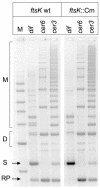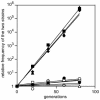A dual role for the FtsK protein in Escherichia coli chromosome segregation
- PMID: 12034757
- PMCID: PMC1084150
- DOI: 10.1093/embo-reports/kvf116
A dual role for the FtsK protein in Escherichia coli chromosome segregation
Abstract
FtsK is a multifunctional protein that acts in Escherichia coli cell division and chromosome segregation. Its C-terminal domain is required for XerCD-mediated recombination between dif sites that resolve chromosome dimers formed by recombination between sister chromosomes. We report the construction and analysis of a set of strains carrying different Xer recombination sites in place of dif, some of which recombine in an FtsK-independent manner. The results show that FtsK-independent Xer recombination does not support chromosome dimer resolution. Furthermore, resolution of dimers by the Cre/loxP system also requires FtsK. These findings reveal a second role for FtsK during chromosome dimer resolution in addition to XerCD activation. We propose that FtsK acts to position the dif regions, thus allowing a productive synapse between dif sites.
Figures





References
-
- Arciszewska L.K., Baker, R.A., Hallet, B. and Sherratt, D.J. (2000) Coordinated control of XerC and XerD catalytic activities during Holliday junction resolution. J. Mol. Biol., 299, 391–403. - PubMed
-
- Aussel L., Barre, F.X., Aroyo, M., Stasiak, A., Stasiak, A.Z. and Sherratt, D. (2002) FtsK is a DNA motor protein that activates chromosome dimer resolution by switching the catalytic state of the XerC and XerD recombinases. Cell, 108, 195–205. - PubMed
-
- Barre F.X. and Sherratt, D.J. (2002) Xer site-specific recombination: promoting chromosome segregation. In Craig, N.L., Craigie, R., Gellert, M. and Lambowitz, A. (eds), Mobile DNA. ASM Press, Washington, DC, Vol. II, pp. 149–161.
Publication types
MeSH terms
Substances
LinkOut - more resources
Full Text Sources
Other Literature Sources
Molecular Biology Databases

